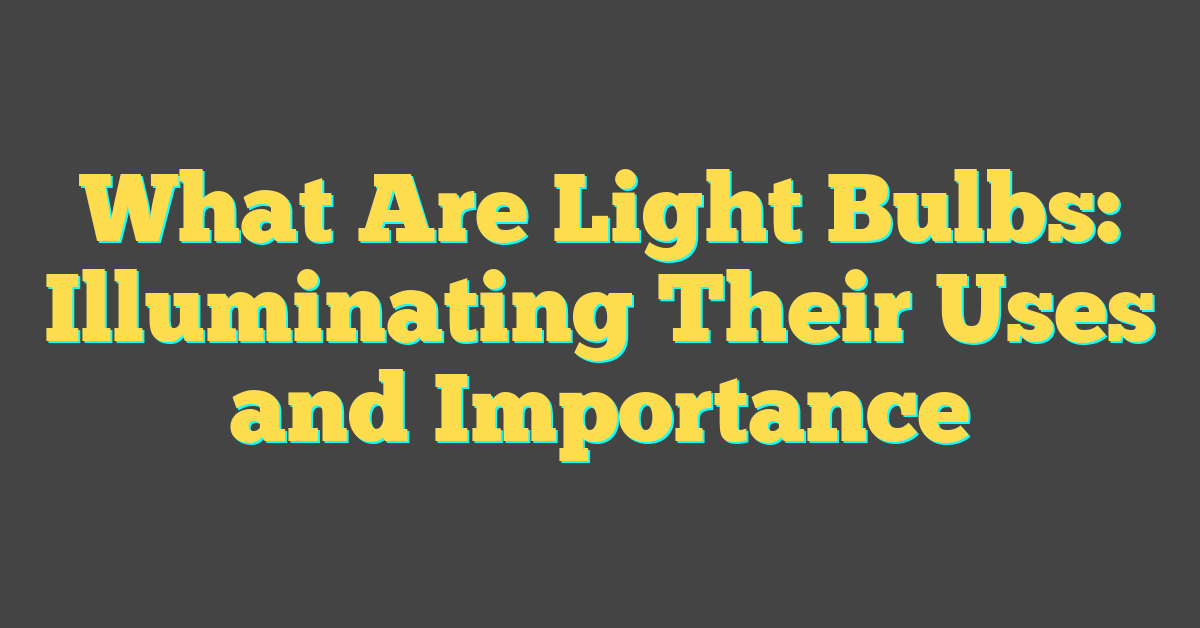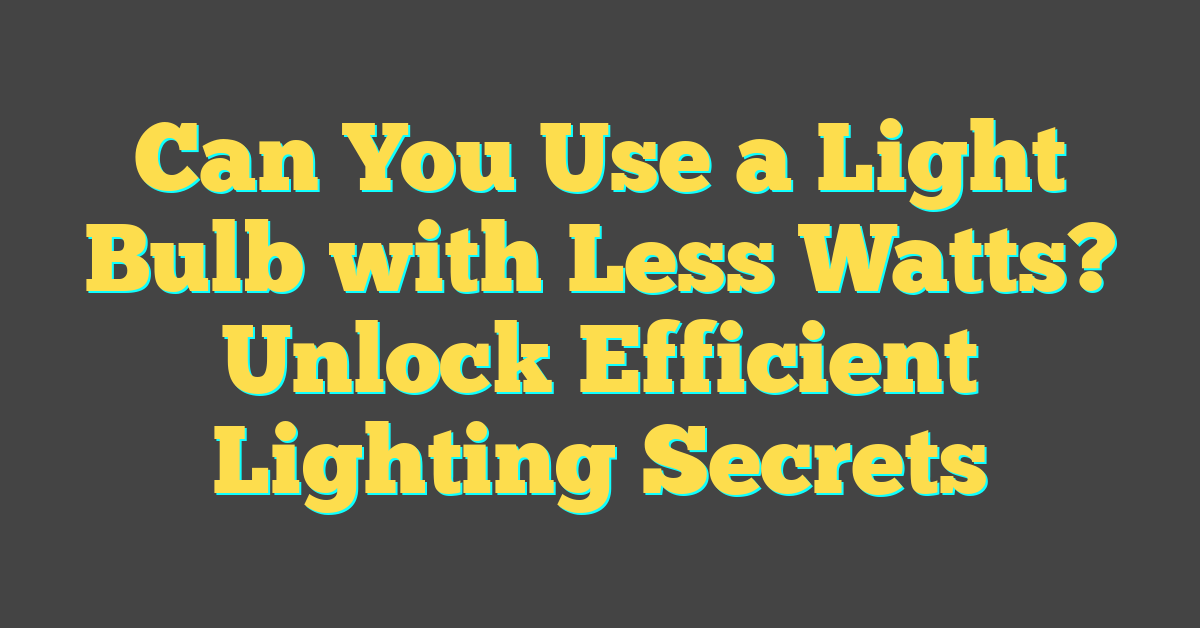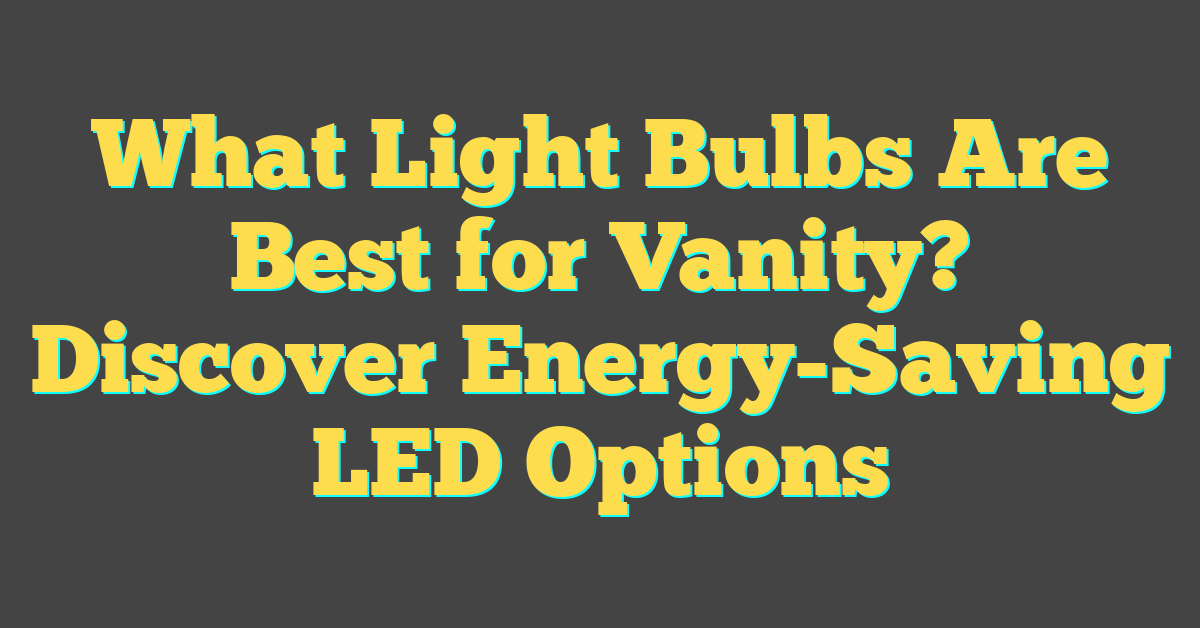Light bulbs are essential to modern living, serving as a cornerstone of daily life by illuminating our homes, workplaces, and public spaces. Their primary function is to convert electricity into light, and their invention marked a significant advancement in human technology. With a rich history that dates back to the 19th century, light bulbs have evolved tremendously over the years. Thomas Edison is often credited with the invention of the practical incandescent bulb; however, many inventors contributed to its development, leading to an array of light sources that we now have today.


As technology progressed, so did the types and efficiencies of light bulbs. The traditional incandescent bulb has given way to more energy-efficient alternatives like compact fluorescent lamps (CFLs) and light-emitting diodes (LEDs). Each type of bulb comes with its own set of specifications, varying in energy usage, lifespan, and light quality. When selecting a bulb, it is essential to consider these factors, as well as the environmental impact of the bulb’s materials and the manufacturing process.
Understanding the components and materials that make up light bulbs is beneficial for making informed choices. Light bulbs consist of a filament or diode, glass enclosure, inert gas, and a metal base that fits into various sockets. With so many shapes and bases available, choosing the right bulb for your specific needs can be more complex than expected. Meanwhile, ongoing advancements in lighting technology continue to offer new solutions for energy efficiency and environmental sustainability, providing opportunities to reduce our ecological footprint while enjoying the benefits of well-lit spaces.
Key Takeaways
- Light bulbs have evolved from incandescent to energy-efficient options like CFLs and LEDs.
- Choosing a light bulb requires considering type, energy efficiency, and environmental impact.
- Components, materials, and bulb design play a significant role in lighting technology and efficiency.
History of Light Bulbs
The invention of the light bulb was a pivotal moment in human history, fundamentally changing the way you live and work. Two significant aspects of this history are the people behind the breakthroughs and the technological advancements that made modern light bulbs possible.
Inventors and Innovations
Thomas Edison is often credited with the invention of the first practical incandescent bulb. However, his success was built on the work of previous inventors. Edison’s main contribution was creating a bulb with a filament that lasted considerably longer than his predecessors’, making it suitable for everyday use. Before Edison, inventors like Humphry Davy and Joseph Swan made notable strides in electric lighting. The 19th-century development of the Geissler tube by Heinrich Geissler and Julius Plücker was also vital, showcasing that light could be produced by passing electricity through gas.
Thomas Alva Edison managed to improve upon earlier designs by optimizing the filament material and the vacuum inside the bulb, which greatly prolonged the life of his bulbs. His design emerged influential and he enjoys a prominent place in the history of light bulbs, eclipsing many other inventors who also played critical roles in its development.
Evolution of Bulb Technology
From the initial incandescent light bulbs to the ones you use today, the technology has undergone significant changes. The frosted lightbulb, introduced in the 1920s, marked an early improvement by diffusing light and reducing glare. Furthermore, advancements in the bulb’s shape and function appeared with the creation of adjustable power beam bulbs for car headlamps and the little one-time flashbulbs for photography in the 1930s. Specialized bulbs like the fluorescent tanning lamp also came into existence during this period.
The 1940s introduced the first ‘soft light’ incandescent bulbs, offering a more comfortable light quality. As you moved into modern homes and businesses, the demand for a variety of bulb types with different functionalities rose. The evolution of bulb technology represents a constant pursuit of efficiency, longevity, and quality of light produced, resulting in diverse lighting options available to you today.
Types of Light Bulbs
When you’re selecting light bulbs for your home or office, it’s essential to understand the different types available. Each kind offers distinct advantages and suits various lighting needs.
Incandescent Bulbs
Incandescent bulbs are the traditional choice that use a wire filament heated to a high temperature to produce light. They’re known for their warm glow and are available in a variety of shapes and sizes, but they’re not as energy-efficient as other types.
Halogen Bulbs
Halogen bulbs are a type of incandescent bulb that utilize a halogen gas to increase light output and improve efficiency. These bulbs are recognized for their bright white light and are often used in spotlights and floodlights.
Fluorescent Bulbs
Fluorescent bulbs consist of a gas-filled tube that emits ultraviolet light when electricity is applied. The UV light then excites a phosphor coating inside the tube to produce visible light. These are common in commercial settings due to their energy efficiency and long life.
Compact Fluorescent Bulbs
Compact fluorescent bulbs (CFLs) are a smaller version of the tubular fluorescent and are designed to replace incandescent bulbs. CFLs use less energy and have a longer lifespan, saving you both energy and money in the long run.
LED Bulbs
LED bulbs (Light-Emitting Diode) are the most energy-efficient lighting option to date. They work by passing an electrical current through a microchip, which illuminates the tiny light sources we call LEDs. The result is a long-lasting and highly efficient source of light.
Understanding Light Bulb Specifications
When you’re choosing a light bulb, paying attention to specifications like wattage, lumens, and color temperature can help ensure you get the right bulb for your needs.
Wattage and Energy Consumption
« What Are 100 Watt Light Bulbs: Understanding Brightness and Efficiency
Best Way to Change Light Bulbs in High Ceilings: Safe & Easy Tips »
Wattage indicates how much energy your light bulb uses. A lower wattage means a bulb uses less energy, making it more energy-efficient, and potentially saving you money on your electric bill. For example, an LED bulb typically uses fewer watts than an incandescent bulb to provide the same amount of light, due to higher efficiency.
Lumens and Brightness
Lumens measure the actual amount of light that a bulb produces, which you perceive as brightness. More lumens mean a brighter light. When you’re looking for new bulbs, consider how bright you want the room to be. For instance, a reading area might require a bulb with higher lumens. Energy-efficient bulbs like LEDs achieve high lumens while still maintaining low wattage.
Color Temperature
The color temperature of a bulb affects the warmth or coolness of the light emitted. It’s measured in Kelvin (K). Lower values, around 2700K, give off a warm light, creating a cozy atmosphere, while higher values, like 6500K, produce a cool light that resembles daylight, suitable for performing tasks requiring focus and attention. Your choice should depend on the mood and function of the space you’re illuminating. Here’s how color temperature influences the appearance of light:
- Warm Light (2700K – 3000K): Resembles incandescent bulbs, suitable for living rooms and bedrooms.
- Cool Light (3100K – 4500K): Often used in kitchens and offices.
- Daylight (4600K and higher): Ideal for reading or task lighting, as it’s the brightest and most akin to natural daylight.
By understanding these specifications, you can select the most appropriate, efficient, and bright light bulb for your purpose.
Energy Efficiency of Bulbs
When you’re choosing light bulbs for your home or office, considering energy efficiency is crucial. Bulbs like LEDs and CFLs can significantly reduce your energy consumption, leading to lower bills and a reduced environmental impact.
Comparing Bulb Efficiencies
LEDs (Light-Emitting Diodes): Known for their impressive efficiency, LED bulbs use up to 90% less energy than traditional incandescent bulbs. Furthermore, LED technology has advanced to offer dimmable options, providing both versatility and efficiency.
CFLs (Compact Fluorescent Lamps): These bulbs are more energy-efficient than incandescents as well, though not as efficient as LEDs. Their energy consumption is lower, and they can save a significant amount of energy over time.
Table 1: Energy Consumption of Light Bulbs
| Bulb Type | Energy Consumption Comparison |
|---|---|
| Incandescent | Uses the most energy |
| CFL | Uses less energy than incandescent |
| LED | Uses the least energy |
Long-Term Savings
Initial Cost vs. Longevity: Although energy-efficient bulbs, like CFLs and LEDs, may have a higher upfront cost compared to traditional bulbs, they offer substantial long-term savings due to their lower energy usage and longer lifespan.
Electric Bill Reduction: Switching to energy-efficient bulbs can also lead to savings on your electric bill. For instance, ENERGY STAR Certified Light Bulbs not only use less energy but also last significantly longer than standard bulbs, which means you’ll save money on replacements as well as energy costs.
List of Potential Savings
- Energy bills reduction by up to $55 over the lifespan of a bulb.
- Fewer replacements needed with LEDs lasting up to 25 times longer than incandescent bulbs.
By considering the energy efficiency of your bulbs, you’re not only being eco-friendly but also ensuring that your investment pays off in the long run.
Impact on the Environment
When you switch on a light bulb, you may not immediately think about its environmental impact. However, certain types of bulbs can have significant effects, particularly concerning their mercury content and the efficiency of their disposal and recycling methods.
Mercury in Bulbs
Traditional fluorescent bulbs contain a small amount of mercury, a toxic substance that can be released into the environment if the bulbs are broken or improperly disposed of. Mercury vapor inside these bulbs is essential for emitting light when an electric current passes through the gas. But when these bulbs break, the mercury vapor can escape and pose health and environmental risks.
Disposal and Recycling Options
To mitigate the environmental risks, it’s essential to consider recycling options. Many communities offer recycling programs specific to light bulbs, which allow for the materials to be safely handled and repurposed. Disposing of light bulbs as regular waste leads to mercury contamination, which is why recycling is not just environmentally friendly, it’s essential. Bulbs labeled as environmentally friendly, like LEDs, have a less harmful impact and are often easier to recycle due to the absence of mercury.
Light Bulb Components and Materials

In your everyday light bulbs, various materials come together to create the bright and functional light you rely on. Each component plays a critical role in delivering light in an efficient and reliable manner.
Filament and Tungsten
Filament is the heart of traditional incandescent light bulbs. Tungsten filaments are incredibly thin, with a typical 60-watt bulb‘s filament stretching about 6.5 feet but only being one-hundredth of an inch thick. This metal is used because of its high melting point and ability to withstand the intense heat generated when electricity passes through it.
LEDs and Diodes
Instead of a filament, LED bulbs contain diodes which emit light when an electric current passes through them. These diodes are semiconductor devices that produce light efficiently and with less heat, making LED bulbs more energy-efficient and long-lasting compared to traditional bulbs.
Inert Gas and Phosphor Coating
An inert gas, typically argon, is used within incandescent bulbs to protect the tungsten filament and increase efficiency as described by Storables. For fluorescent bulbs, a phosphor coating is applied to the inside of the glass. When the inert gas is excited by electricity, it emits ultraviolet light that causes the phosphor coating to fluoresce, producing visible light.
Light Bulb Shapes and Bases
Understanding light bulb shapes and bases is crucial for replacing or upgrading the bulbs in your home. This section breaks down the various shapes and bases to help you find the perfect fit.
Identifying Different Shapes
A19: This is your standard light bulb shape. Most commonly used in household lamps or fixtures, it has a pear-like shape.
MR16: These bulbs are reflective and provide a focused beam of light. They’re typically used in track lighting or spotlight fixtures.
B10: These are decorative candelabra bulbs with a flame shape, often found in chandeliers or sconces.
C7: Small and candle-shaped, these bulbs are usually seen in nightlights or Christmas string lights.
BR30: Bulging reflector bulbs that emit a soft, wide beam—great for recessed can fixtures.
PAR38: Part of the parabolic aluminized reflector family, these provide intense, directed light and are commonly used outdoors.
MR11: Similar to MR16 bulbs but smaller, perfect for desk lamps or accent lighting.
T10: These tubular bulbs work well for picture lights or under cabinet lighting because of their elongated shape. They emit a steady, even light.
Light Bulb Shapes: When choosing a bulb, note that the shape affects the spread and angle of light output. For instance, “BR” means bulged reflector, and it spreads light, while “PAR” means parabolic aluminized reflector, designed for focused light.
Types of Bulb Bases
Screw Bases: The most common type includes E26/E27 medium bases, standard for A19 bulbs, and E12 candelabra bases found in B10 and C7 bulbs.
Pin Bases: These are commonly used for bulbs like MR16s and MR11s. They have two prongs that connect to the fixture.
Bi-pin Bases: Including G4 or GU24 bases, they feature two pins and are used with bulbs that twist and lock into place, like some MR-type bulbs.
Twist-and-Lock Bases: The GU10 base is a common twist-and-lock style, offering a secure fit for track lighting and certain other types of fixtures.
In selecting light bulb bases, compatibility with your fixture is key—ensure the letters and numbers (the code) match, like E26 for the standard medium screw base. Remembering the shapes and base types makes future bulb shopping a breeze.
Choosing the Right Bulb for Your Needs
When selecting a light bulb, it’s essential to consider both its purpose in illuminating your space and the desired ambiance you wish to create. By focusing on these aspects, you ensure that the lighting appropriately complements your environment.
Purpose and Function
You need to think about whether you’re looking for ambient lighting that creates a general illumination in your room or you need task lighting that provides enough light for specific activities like reading or cooking. For ambient lighting, soft white bulbs with a color temperature of 2,700 to 3,000 Kelvin provide a warm glow, conducive to a cozy atmosphere. Task lighting, on the other hand, calls for brighter bulbs. Daylight bulbs with a color temperature around 5,000 to 6,500 Kelvin produce a more crisp and vibrant light, similar to natural daylight, perfect for detailed tasks.
Lighting Design and Aesthetics
The aesthetics of your lighting setup greatly influence the feel of a room. If you prefer a cool white light, which is between soft white and daylight, it will provide a more modern and crisp feel to your space. It’s excellent for rooms that benefit from bright and clear light, such as bathrooms and kitchens. For a warmer, more inviting ambiance, choose warm white bulbs that emit a soft, golden hue. This is particularly effective for living spaces and bedrooms where a cozy vibe is desired. Moreover, if your goal is decorative lighting, then consider how the design of the bulb itself contributes to the room’s overall aesthetics—vintage-style LED bulbs can be as much a design element as a source of light.
Advancements in Lighting Technology
As lighting technology has evolved, you’ve gained access to bulbs that are not only more energy-efficient, but also smarter. These advancements include bulbs that can be controlled remotely and options that are set to transform the way you light up your home in the near future.
Smart Bulbs and Automation
Smart bulbs have brought a significant change in home automation. You can control these innovative lights through your smartphone, set them to change colors, and even program them to adjust based on the time of day. Automated lighting systems integrate with other devices in your home, offering you convenience and energy savings. For example, smart bulbs can automatically turn off when you leave the room, thanks to motion sensors, or they can simulate your presence when you’re away for enhanced security.
Future of Bulb Innovation
Looking ahead, the future of bulb innovation is bright with potential. You can expect light bulbs to become even more integrated with your home’s automation systems, adapting to your personal preferences and habits. Energy efficiency is a key driver of this innovation, with LED technology significantly reducing electricity bills by using less energy than traditional bulbs. Advancements in technology may also introduce features like health monitoring through the light spectrum or enhanced connectivity to smart home ecosystems.
Practical Tips

In the realm of light bulbs, ensuring longevity and safety comes down to proper maintenance and correct fitting. Here’s how you can make the most of your household illumination.
Light Bulb Maintenance
Cleaning: To maintain optimal brightness, clean your light bulbs regularly. Use a soft, dry cloth to wipe dust off when the bulbs are cool and turned off. Avoid using wet cloths or household cleaners, which can damage the bulb or create a hazard.
Inspection: Periodically check your bulbs for any signs of damage or wear, such as flickering, buzzing, or dimming. If these occur, it is time to replace the bulb to maintain efficiency and safety.
Fitting and Replacing Bulbs
Choosing the Right Bulb: Make sure to select the appropriate LED bulb that matches the fixture’s requirements, including base size and wattage.
Turn off power: Before fitting or replacing a bulb, always turn off the power at the switch and allow the bulb to cool down to prevent burns.
Secure fitting: When installing a new bulb, handle it by the base and twist gently but firmly into the socket to ensure a stable connection that won’t shake loose over time.
Remember, these simple steps can greatly extend the life of your light bulbs and reduce the risks associated with improper use.




